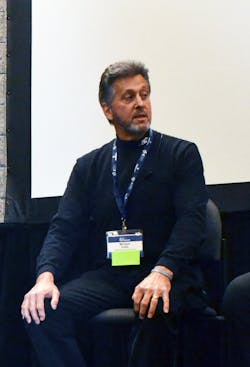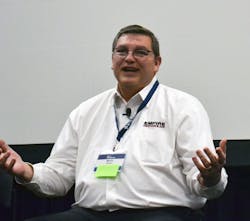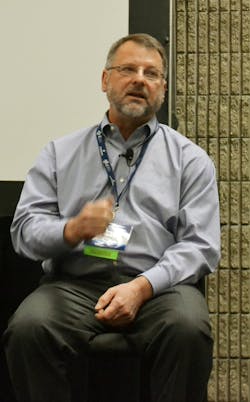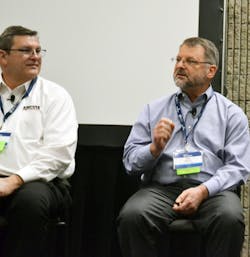Emerson AHR Contractor Panel Discusses Changes in HVAC Refrigerants, Technology
Heating, air conditioning and refrigeration contractors are standing at the intersection of many trends and challenges. These have also brought many questions, some of which have no solid answers. These challenges include the many changes related to refrigerant phaseouts, technician training, and the tremendous expansion of new HVACR technologies.
For the third consecutive year, Emerson Commercial & Residential Systems hosted an "Emerson 360" breakfast at the 2019 AHR Expo in Atlanta, Jan. 14-16. This year's breakfast was designed to help bring some visibility to the changes now at work in HVACR.
The morning's panel discussion was moderated by HARDI Chief Executive Officer Talbot Gee. Contractor panelists — each serving a specific type of customer — were Michael Duffee, owner of Atlanta-based Restaurant Equipment Services, Inc.; Martin Hoover, owner of Empire Heating & Air Conditioning, also based in Atlanta; and Jim Wharton, area Vice President for the Linc Network, ABM.
Discussion began with a look at the challenges imposed on contractors by refrigerant phaseouts.
Michael Duffee spoke of the frustration contractors feel having to manage a virtual constant stream of changes in refrigerant regulations, which of course results in new costs related to new refrigerant purchases. They also find it challenging when they take on a new customers whose equipment service has not been fully documented.
"We’re finding that when we recover refrigerants, we don’t really know what’s in [the system]. Since the transition from R-12, R-22 and R-502 to these other refrigerants, we come across equipment that could contain R-409 and other refrigerants. That’s a big problem, because our customers are very cost-conscious, and they really don’t want to see a $6 per pound charge to dispose of refrigerants. It puts us out of the competitive arena many times, because there are many companies out there that don’t follow any recovery protocol. They’ll just sneak it, and probably release it [into the atmosphere]. So, we’re up against that wall."
Duffee said the contractor's life would be much easier if refrigerant offerings were simplified, and offered a statement that wins the "Wishful Thinking of the Year" award.
“We would like to see the manufacturers and everybody get together and say, ‘This is what we’re offering, and that’s it.’ There can’t be six different refrigerants to replace R-502 or R-22. It has to be one, I believe. Our trucks are limited, and we have to carry at least five or six different jugs of refrigerant.”
Offering the viewpoint of a residential HVAC specialist, Martin Hoover said some of his customers have asked him if there is a refrigerant that can last a lifetime without having to be phased out. If the customer is young, he has to answer truthfully and tell them the system’s refrigerant may very likely have to change two or three more times over a customer’s lifetime.
“I look my customers in the eye and tell them R-410A is the game right now. I don’t know what it’s going to be moving forward; the great minds are working on that. But we have to solidify exactly what direction that’s going to be.”
Hoover is not a fan of flammable refrigerants, which are now available as replacements for some refrigeration systems, nor is he crazy about carbon dioxide. But he realizes that moving forward with either or both alternatives will require technician training.
“CO2 might be great in really small quantities, but you hear of dry ice asphyxiating people, so I don’t really want to have that liability hanging over my head. So, if I’m going to have to re-certify and retrain my whole workforce, I really would like a heads-up on that.” (Ed. Note: dry ice is solid carbon dioxide. Carbon dioxide is not toxic except in very high concentrations, but it will displace all of the air in an area, making it impossible to breath. Source: Wikipedia)
Like Duffee's fleet, Hoover’s company vans carry an assortment of gases, so the techs can be ready for any contingency.
“Much of the time, we walk up to a job now, and we don’t know what we got refrigerant-wise, because who knows who put what in there the last time. When your pressures aren’t all reading true, we have to start from scratch, with evacuation, recovery and recharge, before we can even start [the service]."
Panelist Jim Wharton spoke of the advantages contractors can utilize when "change" is viewed as a legitimate sales opportunity and as a customer educational platform.
“I know that’s a little bit of a cliché, but we’re seeing a lot of equipment sales opportunities. But the challenge is understanding the changes at the sales level, on the street. As technicians perform service on equipment, what are the options? The government, in some situations has made it clear that they have to change that refrigerant, so that’s an opportunity. We’re trying to capitalize on that.”
Discussion moderator Talbot Gee asked if larger commercial air conditioning and refrigeration customers are showing interest in new refrigerant trends, even with the uncertainties.
In response, Duffee said his largest customers are generally apathetic, and primarily interested in cost.
“They’re not at all interested in knowing the specifics,” Duffee said. “Our customers don’t want a lecture on refrigerants and how the changes are impacting them. All they want to know is, what’s it going to cost?
“And, they're frustrated, and they take it out on the service company because we're the only guys they can really take it out on. Nowadays, with R-22 sometimes costing $600 a jug they have to make a hard decision with a system that is working, but is also leaking. Is it time [to replace it]? And I know that Jim said it's an opportunity, but in our business, in our world, the opportunity lies mostly in saving our customers money. They don't like it when you come in with a $6,000 or $7,000 quote to replace all their equipment just because they have R-22 systems. And I know eventually that'll be a moot point because all that stuff will be out of a compatible system. But right now we're in a transitional period, which is typical for us as a small business."
Gee asked: Are there a percentage of customers whom panelists would say like to make proactive decisions, and want to get ahead of refrigerant transitions as soon as possible?
Hoover said about half of his residential customers fall into that category.
"They will trade a lot of knowledge for reducing their carbon footprint. But there are also other people that just want to keep that piece of equipment rolling for as long as they can. And if they change it, and they do change it, especially because that refrigerant is being phased out in 2023, they want to know that the refrigerant they're changing it to is going to give them a good long ride.
"The last thing my customer wants to hear, the year after I install a new $20,000 system, is ‘Oh by the way, that refrigerant's being phased out in four years,’ or something like that," Hoover continued. "Hopefully in their eyes it'll be longer and it'll be available and it won't cost somewhere between $185 and $999 a drum and change every three months. All those things would be good," Hoover said.
"The people that you have strong relationships with tend to listen," Hoover said, "and they listen from a proactive standpoint, and ask, ‘What are my options? What are the costs?’ We really attempt to formulate a relationship, that says, 'Look, this is all good news but this is what's coming,' but also try to look at the total life cycle cost of that equipment. So it's not just about the refrigerant. It's not just about cost-per-pound. It's also about energy efficiency, and how much useful life is there in that equipment. What are some of the tougher advantages in owning new equipment?"
To kickstart a discussion on new technologies, Gee asked panelists to describe some of their favorite new technologies, and how they best learn about new products, and how they prefer to learn.
Jim Wharton said he's been impressed by the data now provided through analytics, which provide more actionable data than a basic alarm.
"And Transformative Wave, because it is a good step in the analytical world. Building Logics is another good step in analytics that really drives decision-making. It's not just an alarm. Why is it an alarm? And what factors put it into alarm. Not just flow, but the duration, or time of day; things like that. So analytics is obviously the future. And I'm anxious about manufacturers really putting analytics to work."
Duffee is impressed by electronic thermostatic expansion valves (TXVs). "We're working with a lot of equipment now that has electronic TXVs, which is a great idea," he said.
"However because the technology behind it in a walk-in cooler environment where it's wet and sometimes caustic with the food and so forth, we see problems with that. Beacon systems for instance and certainly other systems that we've worked with, have been troublesome because of that. A lot of sensors, a lot of microprocessors, and so forth. In our world, that can cause problems, so I just caution the manufacturers to not get too far out there with the basic equipment."
Hoover said he's impressed by the developments in home automation products.
"Customers like the whole home automation, even a buzzer or thermostat pop-up telling them when it's time to change the filter. And if you've got water leak or if your drain line's clogged, they like the fact the system can call me and tell me it's broke before they know it's broke. So maybe we can get there and fix it before it changes the temperature, because we're magic, right?
"Customers like to be able to say 'Hey Siri, turn my thermostat up,' or 'Hey Alexa, turn the lights off.' That's all really cool. I see that only growing and getting better.
Hoover added that system diagnostics are helpful developments for field service teams, that require less skill, but that don't eliminate the need to know how HVAC systems work.
"If you get a trip and pressure switch on a 80% up-flow furnace, it doesn't mean the pressure switch is bad. You actually still have to know how to check the pressure switch and determine if it's the inducer or is it your flue?"
"So, it doesn't take all of the technical training away from a technician. I still can't take a guy straight out of high school and put him in the field. But it certainly makes it easier. And I see that only getting better and better as time goes on."
Hoover continued with comments on the benefits of VRV and generally much more efficient systems.
"We don't sell on return on investment as much as we sell on comfort these days." Hoover said. "The 'green' impact is still a huge issue out there in the marketplace. But I see good manufacturing on the residential side, once you get above the base model units, and up into the more innovative equipment. Onboard diagnostics makes it a little easier for my workforce. A workforce still has to be trained in how to interpret the onboard diagnostics in many cases, but I think pretty soon that's all going to be a common language, and will be a very simple thing that will reduce the broader sense of training for our technical force. We're a little ways from that, but we're well on the way."
How do you learn best? Gee asked.
Michael Duffee said online training is more adaptable to company service schedules, but cost is a factor.
"When I send a man or several men to a seminar, it costs a lot of money to do that, because of a loss of revenue. On the other hand, when we tell them to go online and go through the training, they don't always do that. So it's a Catch-22. In-person training is very helpful. We do have several vendors that provide that service, and we take advantage of that quite a bit. But, maybe if we had a little of both. Have a seminar for hands-on, in-person training, but also provide the online training as well."
Hoover also voted for a combination of online training and in-person instruction.
"You do the online training right off the bat as quick as you can." he shared, "because, as soon as things are in the field we need key people to get up to speed on it.
"Regarding in-person training, the truth is we can't just shut down our company and send everybody in the company to a seminar. So it would be really great if we had those back-to-back. So instead of doing just the Monday and move on to the next city, maybe do a Monday, Tuesday, Wednesday training. And that way I can parse out my labor and I can schedule that ahead of time as long as I know it in advance. Then, having access to the training as a backup online is the best of both worlds."
Alluding to his earlier comment on differing technician skill levels, Hoover said OEMs must design training communication in a mode that's easy to understand.
"And number two, try to get outside of the OEM world and get into our world. It's about customers, and how do I explain this to a customer? How do I take someone on the sales side that is not as much of an expert as all of you. How do we explain this in such a way that they understand it and then can communicate it to the customer? It's a huge challenge.
"We've all heard of the KISS principle. It's got to be very simple or it’s just another seminar we listen to and 10 minutes later you're not sure what you're going to do with it. Educational content has to be actionable," Hoover continued. "Anything presented has got to have an element to it that you can take action on with customers. Otherwise it's just something that's just kind of nice to know. We feel smarter but we're not changing anything."
About the Author
Terry McIver
Content Director - CB
As director of content for Contracting Business, he produces daily content and feature articles for CB's 38,000 print subscribers and many more Internet visitors. He has written hundreds, if not two or three, pieces of news, features and contractor profile articles for CB's audience of quality HVACR contractors. He can also be found covering HVACR industry events or visiting with manufacturers and contractors. He also has significant experience in trade show planning.





